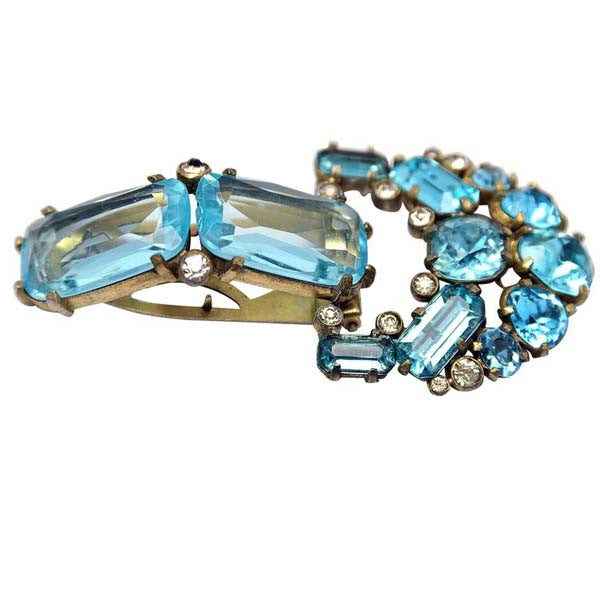Description
ASTOUNDING over sized floral brooch by Joseff of Hollywood. The brooch is a pentagonal wreath featuring full, radial flowers with fractioned leaves that wind their way seamlessly around the frame. The bottom of the wreath features seven brilliant clear crystal chandelier beads that sway independently of each other. A single shimmering bead dangles from the top center of the brooch, adding an extra dose of opulence. The design is reminiscent of early 20th century pieces fashioned for European noblewomen. The brooch has a Russian gold finish, in keeping with its style.
Weight: 54 grams
Eugene Joseff got his start in the late 1920s, after moving to Hollywood from the Midwest. Joseff was charismatic, quickly making friends with production insiders including Walter Plunkett who had made a name for himself in costume design. The silent film era was marked by period films featuring gorgeous, mostly accurate costuming, however, Joseff hand noticed that the jewelry was often times contemporary. Joseff, who had apprenticed at a foundry as a young man, seized the opportunity and soon began to create pieces in his garage, hoping to provide studios with opulent, accurate jewelry.
Before long, Joseff had entrenched himself in Hollywood, becoming the premier jewelry designer for films. His work was desired off screen, and so he found himself creating pieces for celebrities as well as having his work sold in department stores. Business was booming, and Joseff soon found himself hiring Joan Castle. The pair worked together wonderfully, their business relationship turned romantic and the two were married in 1942.
During World War II, Joseff went "from jewelry to jets," when he lent his foundry to the US Government for the production of aerospace parts, while still manufacturing jewelry. The operation was secret, and Joan, who was Canadian, was barred from working in the factory. Joseff of Hollywood has continued to manufacture parts for aerospace companies including Lockheed Martin, Boeing, and General Electric.
Joan made her mark, and during the cocktail jewelry heyday of the 1950s and 1960s she was a standout figure, known for her gatherings, particularly her Christmas parties which featured the famous Joseff Christmas tree which was decorated with gems and jewelry from the studio.
Joan passed away in 2012, leaving the business in the capable hands of Tina Joseff (nee Turner), who had joined the business in the 1970s. She and Jefferey Joseff wed in 1983, after which Tina became increasingly involved in the company to the point where she was running day - to - day operations. The company has stayed in the family, with Tina as president, Jeffrey Joseph Jr. as Vice President, and his wife Kristin running the operations of the business.
-
Country of OriginUnited States
-
ConditionExcellent
-
Materials & Techniques
-
SizeLength
4inWidth
4in
Related Items
1930s Eisenberg Original Aquamarine Rhinestone Fur Clip
$445.00
Absolutely amazing Pre-WWII Eisenberg Original aquamarine rhinestone fur clip. Vintage jewelry collectors agree that there weren't many Jewelers in United States history quite like Eisenberg. Attention to detail, use of fabulous materials, and creativity allowed Eisenberg jewelry to withstand the test of time. Their pieces show the progression of the US and the aspirations of a growing middle class. American woman, while not royalty, could dress and feel like royalty in an Eisenberg Original. The brooch is versatile: use it as a purse clasp, a lapel brooch, a pendant, even a hat pin if you like! The piece is beautiful enough on its own, and would not look amiss on a vanity. Makes a wonderful gift for a loved one or for yourself.
1940s Eisenberg Original Rhinestone Floral Brass Bouquet Fur Clip
Sold Out
Beautiful rhinestone and faux pearl fur clip by Eisenberg. The four blooming flowers and two buds sprout from an antique brass stem. The flowers have emerald cut orange rhinestone centers, each sporting five grey pearl petals. Small round multifaceted white rhinestones decorate the receptacle of the flowers. The "bouquet" features gracefully placed pale yellow rectangular rhinestones, and orange pear and round cut rhinestones. Signed "Eisenberg Original" on reverse.
Eisenberg was founded in 1918 by Jonas Eisenberg, an Austrian Immigrant who had moved to Chicago in 1885. The Eisenberg company initially sold ready-to-wear Womens clothing, but the company had such success with the jewelry they created to go on the garments, that they began designing and manufacturing jewelry as well. In 1958, Eisenberg ceased manufacturing garments, and from then on focused solely on jewelry. During the 1960s and 1970s, Eisenberg partnered with artists, including Picasso, Miro, and Calder. Eisenberg created the creme de la creme of mid century rhinestone jewelry, their pieces often cost more than the average woman’s weekly salary, causing Eisenberg jewelry to be rather rare.
1940s Eisenberg Original Sterling Rhinestone Bouquet Brooch
Sold Out









